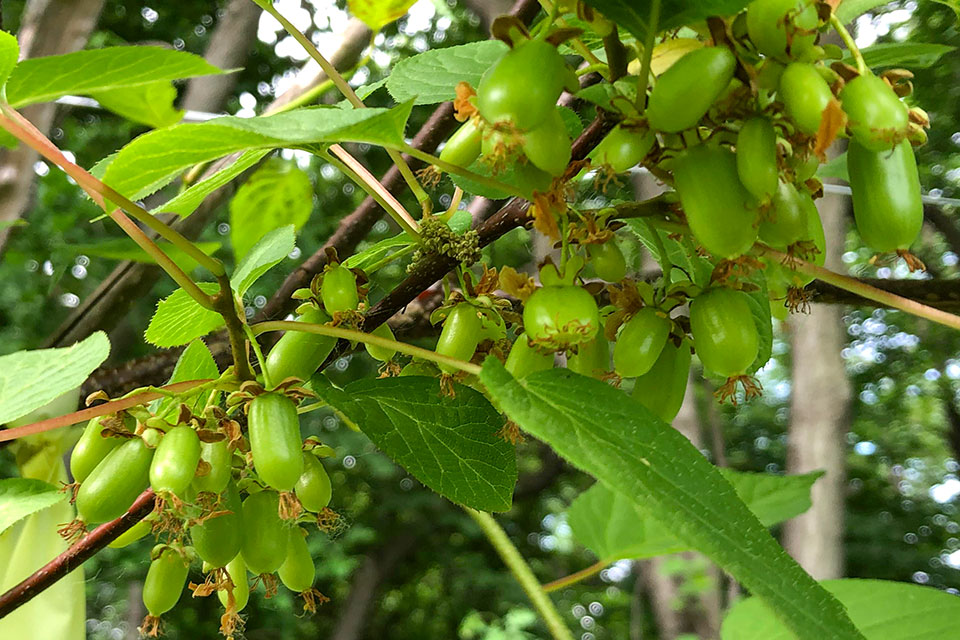Could Kiwiberries Be Your Next Alternative Crop?

Kiwiberries taste similar to kiwifruit but are much smaller and hairless. (Photo: Seth Wannemuehler, University of Minnesota)
Across the country, consumers are becoming interested in trying a wider array of fruit. Seth Wannemuehler, a graduate student at the University of Minnesota, says that means a large potential market for growers.
“[Consumers] go to the grocery store and see dragon fruit, kumquats, and other unusual selections,” he says. “Growers know they can get a premium for locally producing these fruits and selling them at farmers markets.”
But Minnesota’s harsh winters aren’t suitable for growing tropical fruits. Instead, growers are looking for alternative crops. For example, kiwifruit has a group of cousins in the same genus, Actinidia, that can better withstand colder climates. For example, the kiwiberry natively grows from Eastern Russia all the way down throughout China and into Korea and Japan.
Kiwiberries taste similar to kiwifruit but are about the size of a quarter and hairless, making them easy to eat.
“I think kiwiberries are going to gain interest from consumers because a lot of people like kiwifruit, but the berries are easier to eat with an interesting tropical flavor,”
Wannemuehler says.
Is Domestic Production Possible?
The U.S.imports kiwiberries from New Zealand to sell commercially in grocery stores, but Wannemuehler and his advisors think domestic production of kiwiberries could also be feasible.
University professor Jim Luby and local kiwiberry aficionado Bob Guthrie have experimented with growing kiwiberries using seedlings from repositories around the country since the mid-’90s. The two have found that Actinidia arguta and Actinidia kolomikta have performed best.
In 2018, Luby and Guthrie obtained a USDA grant to further screen kiwiberries as a potential fruit crop in Minnesota. Wannemuehler is looking for selections that are cold hardy, have good shelf and storage life, resist pests, provide good nutritional value, and are pleasing to customers’ palates.
Wannemuehler is also considering the chemical constituents of the fruit. Kiwiberries can contain oxalic acid and other chemical components that are slightly allergenic for some people causing odd mouth sensations. Oxalic acid can also bind to calcium and other small minerals to form an insoluble molecule and crystals in the bladder leading to kidney stones. Wannemuehler and his team are developing protocols to detect various molecules to identify and minimize irritating components.
Field Trials
After a year of research, Wannemuehler is finding that both kiwiberry species have different favorable traits. A. kolomikta tend to be more cold-hardy than A. arguta, even bearing fruit after last year’s polar vortex that brought temperatures of -34°F.
“They’re doing great,” he says. “This shows they can survive the harsh Minnesota winters and could be a good choice for growers in the northern part of the state.”
A. arguta is a bit more tender and showed injuries after the harsh winter. However, it offers a slightly more interesting flavor, sweet and tart, grabbing people’s attention in taste tests. Wannemuehler thinks it may perform well for Southern Minnesota growers.
Wannemuehler and his team are working to develop accurate tests to measure levels of vitamin C and oxalic acid.
However, with more than 60 species in the Actinidia genus, Wannemuehler would like to screen and evaluate others.
The grant provides for extension work too, so Wannemuehler also collaborates with small field farmers and home gardeners. He says a handful of local growers are planting kiwiberries with more looking to plant.
The ultimate goal is domestic commercial-scale production. Currently, New Zealand kiwiberries are only available in the grocery store for a couple of weeks in the spring. But because the berries can be harvested prior to full ripening, local production would allow kiwiberries to be available longer in local markets.
“We’ve done auction research that shows consumers interested in kiwiberries are willing to pay (for certain varieties) prices comparable to other berry crops on the market, “ Wannemuehler says.
There are still many questions to answer; Wannemuehler says every day he comes into the office with more. But for now, he focuses on some key ones and hopes to publish more results over the next couple of years.
“I’m glad to be at the right place at the right time to work on this project,” he says. ‘It’s very exciting to be on the leading edge of this.”










